Scottish Schools Adolescent Lifestyle and Substance Use Survey (SALSUS): mental wellbeing report 2018
Mental health and wellbeing findings from the 2018 wave of the Scottish Schools Adolescent Lifestyle and Substance Use Survey (SALSUS).
This document is part of a collection
6 Emotional and behavioural problems, mental wellbeing and friends
The variables analysed in this chapter are whether pupils had one or more close friends, the age of their friends and how many nights they spend out with friends a week. These variables are analysed using the overall SDQ score and the mean WEMWBS score to determine whether each friendship variable was correlated with emotional and behavioural problems and mental wellbeing, respectively.
Number of close friends
Emotional and behavioural problems
The greater the number of close friends a pupil reported, the less likely they were to have a borderline or abnormal overall SDQ score (Figure 6.1).
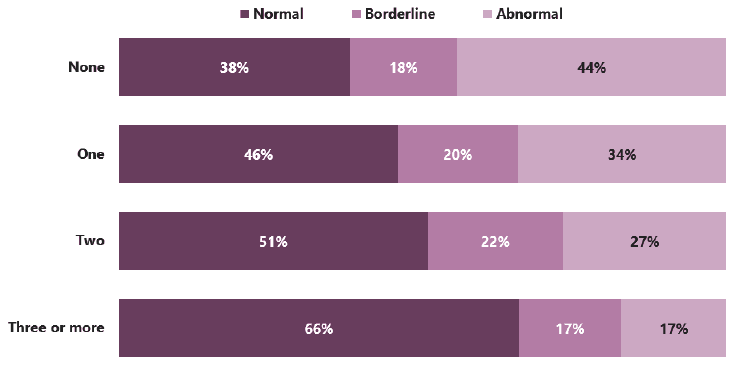
A graph showing overall SDQ scores based on the number of close friends pupils reported.
The figure shows that for pupils who reported that they did not have any close friends, 38% scored within the normal range, 18% scored in the borderline range, and 44% scored in the abnormal range.
It also shows that for pupils who reported one close friend, 46% scored in the normal range, 20% scored in the borderline range, and 34% of abnormal range.
The figure also shows that for pupil who reported two close friends, 51% scored in the normal range, 22% scored in the borderline range, and 27% scored in the abnormal range.
Finally, the figure shows that for pupils with three or more close friends, 66% scored in the normal range, 17% in the borderline range, and 17% in the abnormal range.
Base: See Appendix A
Mental wellbeing
As the number of friends a pupil had increased, so did the mean WEMWBS score (Figure 6.2). Those with three or more friends had the highest average mental health and wellbeing.
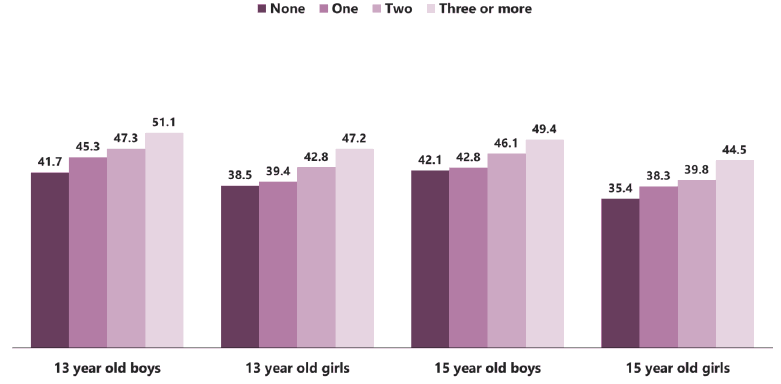
A graph showing the mean WEMWBS score of 13 year old boys and girls, 15 year old boys and girls based on the number of close friends they report having.
The figure shows that 13 year old boys who reported no close friends had a mean score of 41.7 and those who reported one close friend had a mean score of 45.3. 13 year old boys who reported two close friends had a mean score of 47.3, and those that reported three or more close friends had a mean score of 51.1.
The figure also shows that 13 year old girls who reported no close friends had a mean score of 38.5 and those who reported one close friend had a mean score of 39.4. 13 year old girls who reported two close friends had a mean score of 42.8, and those that reported three or more close friends had a mean score of 47.2.
The figure additionally shows that 15 year old boys who reported no close friends had a mean score of 42.1 and those who reported one close friend had a mean score of 42.8. Additionally, those who reported two close friends had a mean score of 46.1, and those that reported three or more close friends had a mean score of 49.4.
Finally, the figure shows that 15 year old girls who reported no close friends had a mean score of 35.4 and those who reported one close friend had a mean score of 38.3. Additionally, those who reported two close friends had a mean score of 39.8, and those that reported three or more close friends had a mean score of 44.5.
Base: See Appendix A
Age of friends
Emotional and behavioural problems
Those who said that they mostly had older friends were most likely to have a borderline or abnormal overall SDQ score, whereas those with friends about the same age as themselves were least likely to have a borderline or abnormal score (Figure 6.3).
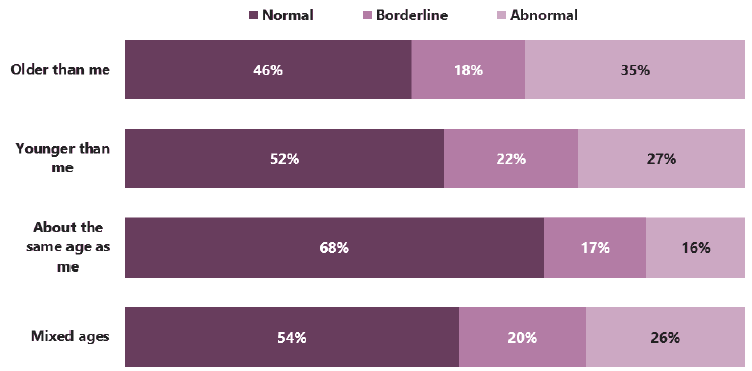
A graph showing overall SDQ scores based on pupils’ reports about the age of their friends.
The figure shows that for pupils who reported that their friends were ‘older than me’, 46% scored within the normal range, 18% scored in the borderline range, and 35% scored in the abnormal range.
The figure also shows that for pupils who reported that their friends were ‘younger than me’, 52% scored within the normal range, 22% scored in the borderline range, and 27% scored in the abnormal range.
Additionally, for pupils who reported that their friends were ‘about the same age as me’, 68% scored within the normal range, 17% scored in the borderline range, and 16% scored in the abnormal range.
Finally, the figure shows that for pupils who reported that their friends were ‘mixed ages’, 54% scored within the normal range, 20% scored in the borderline range, and 26% scored in the abnormal range.
Base: See Appendix A
Mental wellbeing
Among 13 year olds, the same pattern emerged in both genders. Those with friends about the same age had the highest average WEMWBS score, whereas those who had older friends had the lowest (Figure 6.4).
However, among 15 year olds the picture was more complicated. Among boys, it was those with friends younger than them that had the lowest levels of mental wellbeing and those with either friends their own age or of mixed ages that had the highest. In contrast, 15 year old girls who said that most of their friends were younger had the highest average WEMWBS score. In line with 13 year olds, the lowest levels of mental wellbeing among 15 year old girls were among those who had mostly older friends.
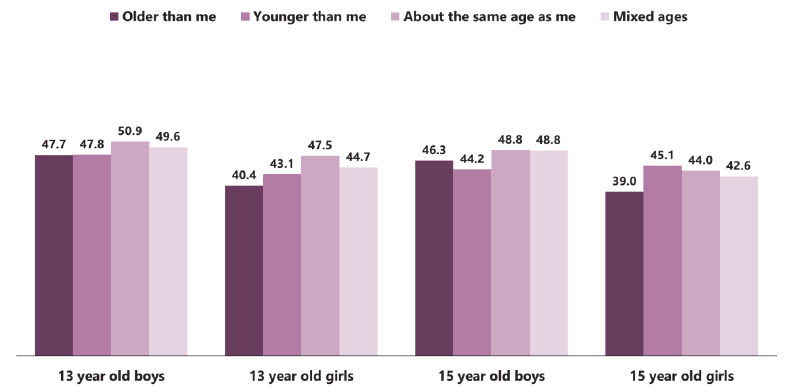
A graph showing the mean WEMWBS score for 13 year old boys and girls, 15 year old boys and girls based on their report of the age of their friends.
The figure shows that 13 year old boys who reported that their friends were ‘older than me’ had a mean score of 47.7. Those who reported ‘younger than me’ had a mean score of 47.8, those who reported ‘about the same age as me’ had a mean score of 50.9, and those that reported that their friends were of ‘mixed ages’ had a mean score of 49.6.
The figure also shows that 13 year old girls who reported that their friends were ‘older than me’ had a mean score of 40.4. Those who reported ‘younger than me’ had a mean score of 43.1, those who reported ‘about the same age as me’ had a mean score of 47.5, and those that reported that their friends were of ‘mixed ages’ had a mean score of 44.7.
Additionally, the figure shows that 15 year old boys who reported that their friends were ‘older than me’ had a mean score of 46.3. Those who reported ‘younger than me’ had a mean score of 44.2, those who reported ‘about the same age as me’ or ‘mixed ages’ both had a mean score of 48.8.
Finally, the figure shows that 15 year old girls who reported that their friends were ‘older than me’ had a mean score of 39. Those who reported ‘younger than me’ had a mean score of 45.1, those who reported ‘about the same age as me’ had a mean score of 44, and those that reported that their friends were of ‘mixed ages’ had a mean score of 42.6.
Base: See Appendix A
Number of evenings out with friends
Emotional and behavioural problems
As the number of evenings out with friends increases so does the proportion of pupils with a borderline or abnormal overall SDQ score (Figure 6.5). However, those that spent no evenings out with friends at all, were also more likely to have borderline or abnormal scores than those that spent a moderate number of evenings out a week (1 to 2 or 3 to 4 evenings out).
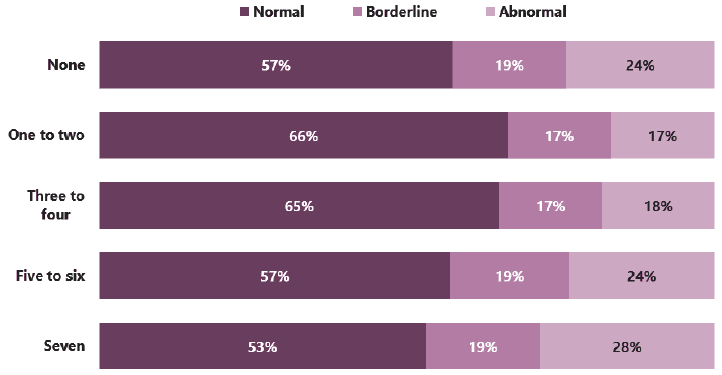
A graph showing overall SDQ scores based on the number of evenings pupils reported they spent out with friends per week.
The figure shows that for pupils who reported that they did not spend any evenings out with their friends, 57% scored within the normal range, 19% scored in the borderline range, and 24% scored in the abnormal range.
The figure shows that for pupils who reported that they spend one to two evenings out with their friends, 66% scored within the normal range, 17% scored in the borderline range, and 17% scored in the abnormal range.
The figure shows that for pupils who reported that they spend three to four evenings out with their friends, 65% scored within the normal range, 17% scored in the borderline range, and 18% scored in the abnormal range
The figure shows that for pupils who reported that they spend five to six evenings out with their friends, 57% scored within the normal range, 19% scored in the borderline range, and 24% scored in the abnormal range.
The figure shows that for pupils who reported that they spend seven evenings out with their friends, 53% scored within the normal range, 19% scored in the borderline range, and 28% scored in the abnormal range.
Base: See Appendix A
Mental wellbeing
The association between mental wellbeing and number of evenings spent out with friends was less distinct, but followed the same pattern. Those at the extremes, either spending no evenings or seven evenings out with friends, had the lowest levels of mental wellbeing (Figure 6.6).
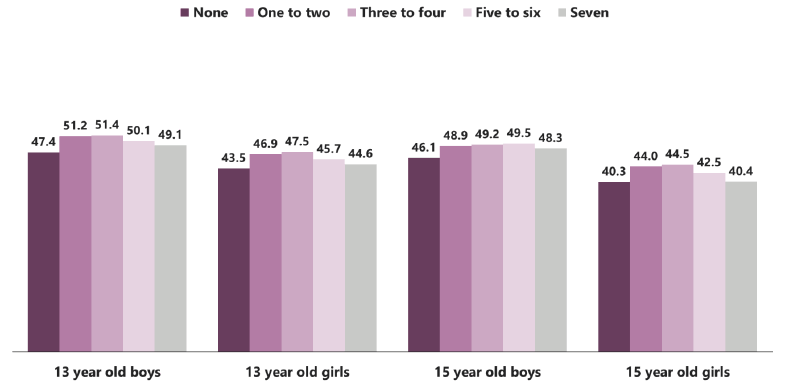
A graph showing the mean WEMWB score for 13 year old boys and girls, 15 year old boys and girls based on the reported number of evenings they spent out with friends per week.
The figure shows that 13 year old boys who reported that they did not spend any evenings out with their friends had a mean score of 47.4. Those who reported that they spend one or two evenings out with their friends had a mean score of 51.2, those who reported that they spend three to four evenings out with their friends had a mean score of 51.4, those who reported that they spend five to six evenings out with their friends had a mean score of 50.1, and those who reported that they spend seven evenings out with their friends had a mean score of 49.1.
The figure shows that 13 year old girls who reported that they did not spend any evenings out with their friends had a mean score of 43.5. Those who reported that they spend one or two evenings out with their friends had a mean score of 46.9, those who reported that they spend three to four evenings out with their friends had a mean score of 47.5, those who reported that they spend five to six evenings out with their friends had a mean score of 45.7, and those who reported that they spend seven evenings out with their friends had a mean score of 44.6.
The figure shows that 15 year old boys who reported that they did not spend any evenings out with their friends had a mean score of 46.1. Those who reported that they spend one or two evenings out with their friends had a mean score of 48.9, those who reported that they spend three to four evenings out with their friends had a mean score of 49.2, those who reported that they spend five to six evenings out with their friends had a mean score of 49.5, and those who reported that they spend seven evenings out with their friends had a mean score of 48.3.
The figure shows that 15 year old girls who reported that they did not spend any evenings out with their friends had a mean score of 40.3. Those who reported that they spend one or two evenings out with their friends had a mean score of 44, those who reported that they spend three to four evenings out with their friends had a mean score of 44.5, those who reported that they spend five to six evenings out with their friends had a mean score of 42.5, and those who reported that they spend seven evenings out with their friends had a mean score of 40.4.
Base: See Appendix A
Contact
Email: salsus@gov.scot
There is a problem
Thanks for your feedback